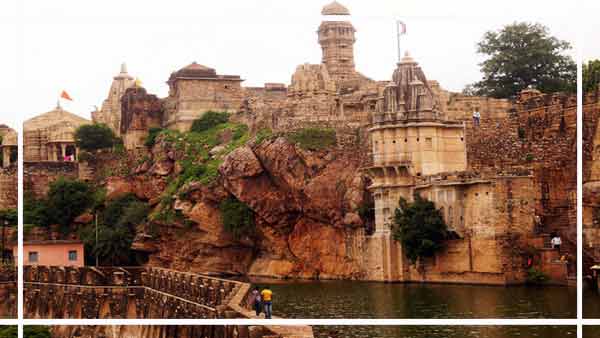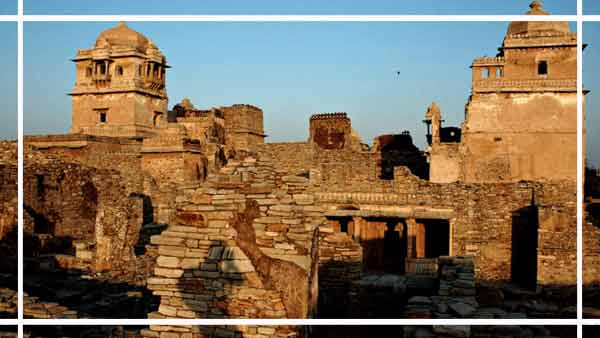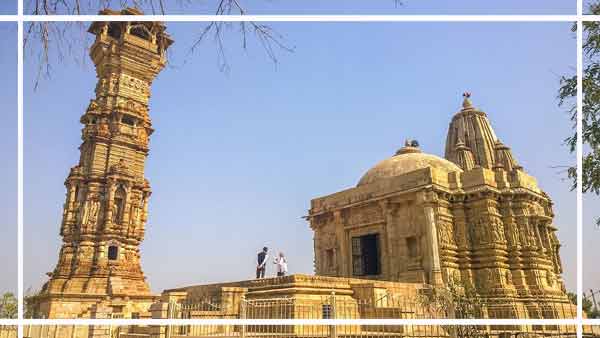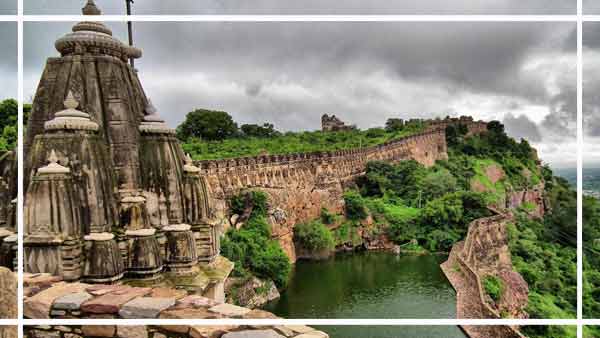Chittorgarh Destination Rajasthan ‘s state is culturally rich, and historically significant. Chittorgarh is one of the popular tourist travel destinations in Rajasthan. City of Chittorgarh sits on the banks of the Berach and Gambini rivers. The Chittorgarh fort is one of the main landmarks in the region. Chittorgarh once ruled by the Mewar Sisodia dynasty is reminiscent of the brave kings who ruled this kingdom.
Chittorgarh’s fort was home to a fiercely independent king’s clan which fought three invasions. The women at Chittorgarh fort committed Johar three times. Several of Chittorgarh ‘s prominent warriors include Jaimal, Phata, Badal and Gora who fought a tough battle against invaders like Allaudin Khilji and the Mughals Chittorgarh Destination.
Bassi wildlife sanctuary is situated 5kms away from the Chittorgarh. This sanctuary is home to panthers, mongoose, wild boars and migratory birds, extending over 50 sq km. Other places of interest are the Kalika Mata Temple, the Vijay Stambh, the Kirti Stambh, the Palace of Rani Padmini, the Fateh Prakash Palace, etc.
The Golden Quadrilateral highway system which passes through the city connects Chittorgarh Destination well with the rest of India. The NH 76 and 79 lies in the city of Chittorgarh. There is a regular bus service on the state roads which can be used to reach Chittorgarh. Chittorgarh Railway Station is the closest railhead to the town of Chittorgarh. The nearest airport is Udaipur which is 70 km from Chittorgarh Destination.
Major Attractions in Chittorgarh – Chittorgarh Destination
Chittorgarh Fort

Chittorgarh Fort is an ancient hill fort situated in Chittorgarh town of Rajasthan, at a distance of 7 km from Chittorgarh Railway Station. It is one of India’s largest forts, and also one of Rajasthan ‘s top heritage sites. It is a World Heritage Site included in Rajasthan’s Hill Forts, and also one of the top places to visit as part of the journey to Rajasthan.
The original Fort Chittorgarh was built in the 7th century A.D. by the Maurya dynasty. After Chitrangada Mori, a Rajput chieftain written on historical Mewari silver coins, she was then known as Chitrakut. Historically, the Mori dynasty was in control of the fort when Chittorgarh Destinationwas conquered by Bappa Rawal, the founder of the Mewar empire, and made it his capital in 734 A.D. His descendants then ruled Mewar, extending from Gujarat to Ajmer until the 16th century A.D.
Rana Kumbha Palace

Rana Kumbha is a heritage palace situated within the Chittorgarh Fort Complex near Vijay Stambh, at a distance of 6 km from Chittorgarh Railway Station. It is one of the best places to stay at Fort Chittorgarh.
Maharana Kumbha reconstructed the palace on a ruined palace that was built by Bappa Rawal in 734 A.D. He was renowned within the Mewar dynasty of Rajasthan for his art and cultural patronages. It is the Rajput King Maharana Kumbha who lived his royal life in this Palace. The most massive monument at Chittor Fort is the ruined Kumbha Palace.
According to legends, here was born the father of the city of Udaipur, Maharana Udai Singh, and his life was saved by his wet nurse Panna Dhai who sacrificed her own son and succeeded in bringing a young Udai Singh to a safe destination. This place once was the home of Meerabai, the famous bhakti poetess.
Kirti Stambh / Tower Of Fame

Kirti Stambh or the Tower of Fame is an ancient Jain monument within the Chittorgarh Fort Complex, at a distance of 800 m from Kumbha Palace and 7.5 km from Chittorgarh Railway Station.
Kirti Stambh is a 12th century tower designed during the reign of Rawal Kumar Singh by a Jain merchant, Jijaji Bhagerwala. The key goal behind their commission was to glorify Jainism. This six storied 22 m high tower is dedicated to Adinath, the first Jaina Thirthankara.
Designed in architecture of Solanki style, it has numerous columned balconies, latticed arches, and intricately carved niches. The tower is embellished with numerous naked Thirthankar figures which indicate that it belonged to the Digambara sect. Photos of standing Adinatha are portrayed on all four cardinal directions in the lower storey, while upper stories contain hundreds of miniature portraits of Jain deities. There are a number of inscriptions of Jain inside and outside the house, dating it to 896 AD Chittorgarh Destination.
Fateh Prakash Palace Museum
Fateh Prakash Palace is situated near Rana Kumbha Palace, 7.7 km from Chittorgarh Railway Station, and within the Chittorgarh Fort Complex, close to the Badi Pol.
Rana Fateh Singh designed the Fateh Prakash Palace, and it was named after him. This magnificent double-storeyed palace represents a fine example of modern Indian architecture. It is an edifice with a tower topped with domed chhattries at each of its four corners. The palace reflects the tendency of the maharaja towards architecture, and is renowned for its pillars and corridors. A large portion of the palace was converted to a public museum during the year 1968 Chittorgarh Destination.
The museum is divided into parts dedicated to the various antiquities such as Bassi village coins, paintings, weapons, tribal life, and wood crafts. Within this museum is harbored a wide number of sculptures and most deities.
Kumbha Shyam Temple & Meerabai Temple
Kumbha Shyam Temple is a Hindu temple within Chittorgarh Fort, at a distance of 350 m from Kumbha Palace and 6 km from Chittorgarh Railway Station. It is one of the famous temples in the Chittorgarh Fort Complex and also one of the top places in Chittorgarh to visit.
Kumbha Shyam Temple was built in 1448 AD, by Rana Kumbha. Varaha, an incarnation of Lord Vishnu, is dedicated to the temple. While in the same context there is also a Kali Mata temple and Meerabai temple but the scale of the Kumbha Shyam temple dominates. This temple is where Meera used to worship Lord Krishna and the movement of Bhakti started at this location Chittorgarh Destination.
Constructed in Indo Aryan style, the temple features a compact architecture. The temple has a unique roof-like pyramid, with a high tower. The temple lies on an elevated plinth. The temple has an open pradakshinapath, ardha-mandapa, central mandapa, garbhagriha, and antarala. Inside the temple the sculptures of various Hindu Gods and Goddesses are fascinating.
Ratan Singh Palace
Located in Chittorgarh Fort, Ratan Singh Palace or Ratan Singh Mahal is a big historic palace at a distance of 1 km from Rana Kumbha Palace and 6 km from Chittorgarh Railway Station. This palace, situated along the Ratneshwar Talab, is one of the top places to visit in Chittorgarh.
Attributed to Rana Ratan Singh II (AD 1528-31), the Ratan Singh Palace is. This is plan rectangular and it is surrounded by a high wall. The main entrance faces east through a high arch, with two pillared chhatris crowned. The palace consists of a courtyard surrounded by rooms on the eastern part of the second floor and a pavilion with balcony Chittorgarh Destination.
There is a gate on the north side of the palace which leads to the inner part of the palace. There is large empty space in the inner portion, and numerous old structures and rooms are made around it. Darikhana is on the eastern part of the second story with fine balcony overlooking the reservoir. At the north of the main gateway is a temple known as the Ratneshwar Mahadeva Temple.
Rani Padmini Palace / Padmini Mahal
Padmini Palace is located at the southern part of Chittorgarh Fort, at a distance of 1.5 km from Kumbha Palace and 7.5 km from Chittorgarh Railway Station. It is one of Rajasthan’s most popular hitorical sites to visit, and also one of the best places to visit in Chittorgarh.
Padmini Palace once was the palatial abode of King Rawal Ratan Singh’s exquisitely beautiful Rajput queen, Rani Padmini, aunt. Revered as an epitome of grace, Rani Padmini was Gandharvasen ‘s daughter of a Sinhala ruler and plays a crucial role in the history of the gallant Rajput warriors. This queen was mentioned by Malik Muhammad Jayasi in the epic poem of ‘Padmavati,’ written during 1540 CE.
Rani Padmini Palace leaves the shimmer of past grace, bravery, sacrifice, honor, and tragedy behind. Padmini Palace was the very legendary palace from which Ala-ud – din Khilji could get a glimpse of Padmini

